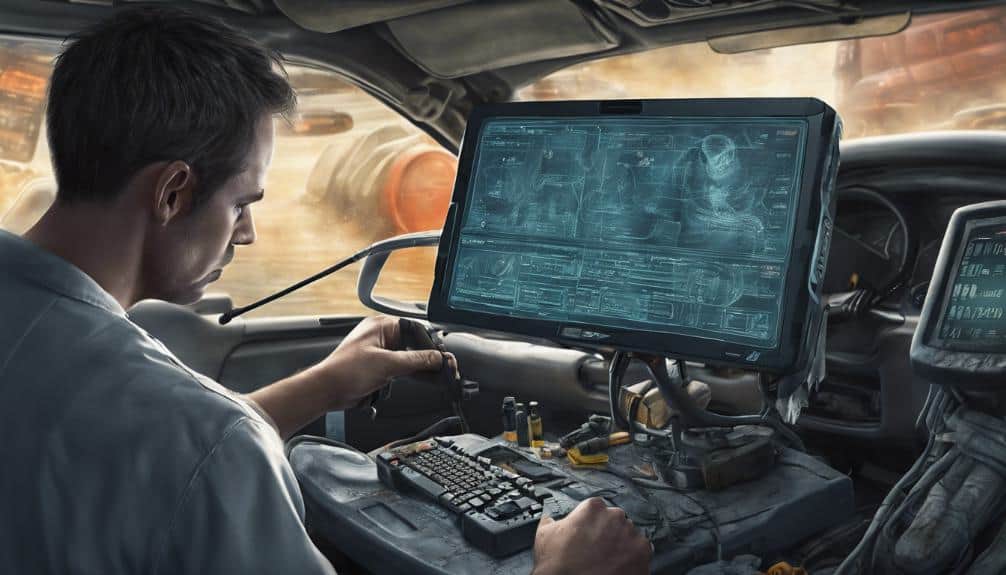When it comes to vehicle testing, understanding drive cycles can greatly impact your results.
By mastering the basics of drive cycles, you can guarantee accurate emissions readings and address potential issues effectively.
Properly following drive cycle instructions tailored to your vehicle model is key, but there’s more to it than just that.
Key Points
- Understand the specific drive cycle for your vehicle model.
- Thoroughly inspect and maintain your vehicle before testing.
- Check and resolve any Diagnostic Trouble Codes (DTCs) detected.
- Complete the drive cycle steps as outlined for effective testing.
- Following drive cycle basics ensures emissions readiness and increased testing success.
Importance of Understanding Drive Cycles

Understanding drive cycles is essential for ensuring your vehicle’s onboard computer is properly prepared for emissions testing.
By comprehending the specific drive cycle recommended by your vehicle’s manufacturer, you contribute to the accuracy of the emission testing results.
These drive cycles serve an important role in detecting any underlying issues within your vehicle’s emissions systems.
They’re designed to prevent false readings or incomplete data during emissions testing, ultimately aiding in the prevention of potential misdiagnoses.
Following the drive cycle guidelines diligently greatly increases the likelihood of successfully passing the smog test.
Hence, it’s imperative to familiarize yourself with the drive cycle requirements for your specific vehicle model.
Preparing the Vehicle for Testing
To guarantee successful preparation for testing, thoroughly inspect your vehicle for any signs of smoke, leaks, or abnormalities under the hood.
Adequate vehicle maintenance is essential to ensure emission readiness and peak performance during the drive cycle.
Before starting the testing process, make sure all repairs are completed, and the vehicle is in excellent working condition.
Checking for any potential issues like smoke, leaks, or unusual sounds under the hood can help address them promptly.
Properly preparing your vehicle for testing is vital to ensure emission systems are functioning correctly and readiness for the smog test.
Ensuring that your vehicle is well-maintained increases the likelihood of a successful drive cycle and accurate results. Hence, take the time to inspect your vehicle thoroughly before beginning the testing process.
By addressing any issues beforehand, you can enhance the effectiveness of the drive cycle and improve the overall testing outcome.
Checking for Diagnostic Trouble Codes

Prior to beginning the drive cycle, make sure you use an OBD2 scanner to check for any diagnostic trouble codes (DTCs) that may indicate issues with the vehicle’s emissions systems.
This step is essential in ensuring that your vehicle is ready for emissions testing.
Here are some essential points to keep in mind:
- OBD2 Scanning: Utilize an OBD2 scanner to retrieve DTCs stored in the vehicle’s computer system.
- Troubleshooting: Look for both current and pending DTCs to identify any problems related to the emissions systems.
- DTC Identification and Resolution: Address and resolve any DTCs found before proceeding with the drive cycle to prevent inaccurate testing results.
How Often Should I Perform Vehicle Testing in Addition to Regular Oil Changes?
It is recommended to perform an oil change for Corolla every 3,000 to 5,000 miles, depending on the type of oil used and driving conditions. In addition to regular oil changes, vehicle testing should be done annually or as recommended by the manufacturer to ensure optimal performance and safety.
Steps for Completing the Drive Cycle
Prior to starting the drive cycle, make sure that any diagnostic trouble codes identified with the OBD2 scanner are addressed to guarantee accurate emissions testing results.
To complete the drive cycle effectively, start by letting your vehicle idle for 15 to 25 minutes to warm up before hitting the road.
Then, drive over 65 mph on the highway for 15 to 25 minutes to fulfill the highway driving phase.
Next, navigate city streets for 15 to 30 minutes, covering good mileage, and remember to idle for 5 to 10 minutes.
Make certain your vehicle operates at higher speeds and in stop-and-go traffic during the drive cycle.
How Can Vehicle Testing Help Maintain a Healthy Car Battery?
Regular vehicle testing using the best car battery testers is crucial for maintaining a healthy car battery. These testers can help identify any issues with the battery early on, allowing for timely maintenance and preventing potential breakdowns. Proper testing ensures the longevity and reliability of the car battery.
Benefits of Following Drive Cycle Basics

Observing drive cycle basics confirms that your vehicle’s emissions systems are functioning properly and ready for testing.
By following these essential steps, you guarantee drive cycle efficiency and emissions readiness, enhancing the effectiveness of your vehicle testing process.
The benefits of adhering to drive cycle basics include:
- Improved Drive Cycle Efficiency: Properly completing the drive cycle helps in preventing diagnostic trouble codes from appearing during testing, ensuring that your vehicle is operating at its best.
- Enhanced Emissions Readiness: Completing a drive cycle correctly readies the onboard computer for emissions testing, increasing the likelihood of passing a smog test with ease.
- Vehicle Roadworthiness: Following drive cycle basics is essential to make sure that your vehicle meets emissions regulations, making it roadworthy and compliant for everyday use.
Ensuring Compliance With Emissions Regulations
To guarantee compliance with emissions regulations, it’s essential to adhere to the specific driving conditions outlined in the drive cycle.
Following the drive cycle accurately is fundamental for emission testing compliance.
The drive cycle includes various scenarios like city streets driving, which helps simulate stop-and-go traffic conditions necessary for emission system testing.
By completing the drive cycle as specified, you increase the likelihood of passing an emissions test.
Ensuring your vehicle meets these requirements is critical not only for environmental reasons but also to avoid failing emissions tests or facing penalties for non-compliance with regulations.
Make sure to follow the drive cycle instructions closely to maximize the effectiveness of your vehicle’s emissions systems.
Proper adherence to the drive cycle is key to setting readiness monitors and ensuring successful emissions testing.
By understanding and following these guidelines, you can navigate the drive cycle efficiently and effectively to achieve emission compliance.
As an Amazon Associate we earn from qualifying purchases.










